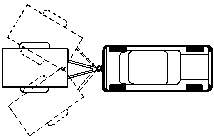Advertisement
Features Index > Towing and Towcars and Towball Carriers > The Use of Stabilisers
The Use of Stabilisers
|
Stabilisers are not intended to be a substitute for sound practice in loading
and towing. They are valuable, particularly with caravans and horse
trailers, and other high-sided trailers. They will not, however, overcome
problems created by poor loading or poor driving.

Follow the golden rules of towing:
- Set up the trailer so that is level when coupled to the towing vehicle.
- Make sure the nose weight is between 50 and 100kg (unless trailer is very
light.)
- Make sure the tyre pressures are correct.
It should be remembered that you must not travel in the right-hand lane of a
motorway, with three lanes or more, if you are driving a vehicle drawing a
trailer.
The main purpose of a stabiliser is to stop a trailer or caravan from
becoming unstable and '"snaking" from side to side. They come in various forms
and designs. The most popular types are the trailing arm leaf spring and the
coupling head stabiliser."Snaking" is when the axles of the caravan/trailer move out of line from the
towing vehicle. When this happens, the trailer/caravan tries to move back into
line and it goes too far. This action starts the cycle of "snaking" from side to
side. Unless the snaking is stopped, it will increase and will cause the driver
to lose control. Snaking can be caused by a number of factors such as: |
- Incorrectly placed loads (excessive loading to the rear of the axle(s))
- Very light or negative nose weight
- Side winds (when a large commercial vehicle or coach overtakes and causes
the air to buffet the caravan/trailer, moving the axles out of alignment)
- Special purpose built trailers having awkward internal fixtures that may
be not balanced, causing instability.
|
 |
To stop snaking there are a few simple rules:
- Keep the vehicle steering in a straight line
- Change down a gear and take both feet off the pedals
- If the snaking starts whilst going down hill, change down a gear and very
gently apply the brakes
- Do not try to accelerate out - this could end in disaster unless the
vehicle is exceptionally powerful.
- Do not brake hard - this may cause the trailer to jack knife.
- Do not try to steer out - it is very difficult to read the snaking action
and it can make it worse.
Stabiliser Checks:
(Each manufacturer will have their own servicing and checks guide, which should
be contained within the handbook or fitting instructions.)
- Stabilisers must be checked at the start of each journey
- Check that the friction is apparent (if possible)
- Check that the stabiliser fits into its locating place properly
Stabiliser Servicing:
Stabilisers must be overhauled thoroughly at least once a year or after 20K
miles towing. (whichever is sooner). The stabiliser must be dismantled and any
pads or friction disks must be inspected for cracking or excessive wear. NB:
Beware of servicing older stabilisers because the friction pads or disks may
contain asbestos. These should be handled and disposed of carefully
|
|
Index : Towing and Towcars and Towball Carriers : The Use of Stabilisers - by NTTA
Latest News, Discounts and Competitions see all...
|
5635 Visitors online !
Free UKCampsite.co.uk Window Sticker - Recommend to Friend - Add a Missing Campsite
[Message Forums]
[Caravan Sites & Camping]
[Company Listings]
[Features / Advice]
[Virtual Brochure]
[Special Offers]
[Reception]
[Competitions]
[Caravans & Motorhomes For Sale]
[Event Diary]
[Contact Us]
[Tent Reviews]


Please note we are not responsible for the content of external sites & any reviews represent the author's personal view only. Please report any error here. You may view our privacy and cookie policy and terms and conditions here. All copyrights & other intellectual property rights in the design and content of this web site are reserved to the UKCampsite.co.uk © 1999 - 2025 |

Advertisement
|
|
Advertisement
|








